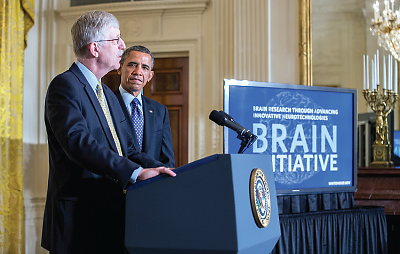In June, the National Institutes of Health (NIH) called for $4.5 billion in new federal funding over 10 years—beginning in Fiscal 2016—for research as part of the Brain Research through Advancing Innovative Neurotechnologies (BRAIN) Initiative.
The ambitious multibillion-dollar research effort, which was announced by President Obama last year, would quadruple the initial budget for the multiyear project from $100 million a year to $400 million for the initial five years and $500 million for the next five years (Psychiatric News, May 3).
“While these estimates are provisional and subject to congressional appropriations, they represent a realistic estimate of what will be required for this ‘moon shot’ initiative,” said NIH Director Francis Collins, M.D., Ph.D. “As the Human Genome Project did with precision medicine, the BRAIN Initiative promises to transform the way we prevent and treat devastating brain diseases and disorders while also spurring economic development.”
The BRAIN Initiative is a collaborative effort led by the NIH, Defense Advanced Research Projects Agency of the Department of Defense, National Science Foundation, and Food and Drug Administration. It has garnered enthusiastic support from advocacy and professional medical organizations whose members treat or are affected by brain-related illnesses.
“Our patients and their families need access to a range of treatment options and deserve to experience the promise of future psychopharmacological breakthroughs,” APA CEO and Medical Director Saul Levin, M.D., M.P.A., and APA President Paul Summergrad, M.D., told the House Energy and Commerce Committee. “The BRAIN Initiative promises significant breakthroughs to treat neurological diseases, including mental illness and substance use disorders, which require technological innovations to develop new ways of mapping neurological pathways. APA urges the committee to support these vital research efforts.”
The NIH efforts on the BRAIN Initiative will divide $40 million a year in funding for brain research areas that are considered high priority (Psychiatric News, January 16) in order to map the circuits of the brain, measure the fluctuating patterns of electrical and chemical activity flowing within those circuits, and understand how such factors interplay to create specific cognitive and behavioral capabilities.
The NIH plans to achieve goals through the following core principles:
Identify and provide experimental access to the different brain-cell types to determine their roles in health and disease.
Generate circuit diagrams that vary in resolution from synapses to the whole brain.
Produce a dynamic picture of the functioning brain by developing and applying improved methods for large-scale monitoring of neural activity.
Link brain activity to behavior with precise interventional tools that change neural circuit dynamics.
Produce conceptual foundations for understanding the biological basis of mental processes through development of theoretical and data-analysis tools.
Develop innovative technologies to understand the human brain and treat its disorders; and create and support integrated brain research networks.
Integrate new technological and conceptual approaches produced in the other goals to discover how dynamic patterns of neural activity are transformed into cognition, emotion, perception, and action in health and disease.
“How the brain works and gives rise to our mental and intellectual lives will be the most exciting and challenging area of science in the 21st century,” said Collins. “As a result of this concerted effort, new technologies will be invented, new industries spawned, and new treatments and even cures discovered for devastating disorders and diseases of the brain and nervous system.”
The NIH emphasized that its cost estimates for the budget for the BRAIN Initiative will be needed to supplement—not supplant—the agency’s existing investment in the broader spectrum of basic, translational, and clinical neuroscience research. ■

